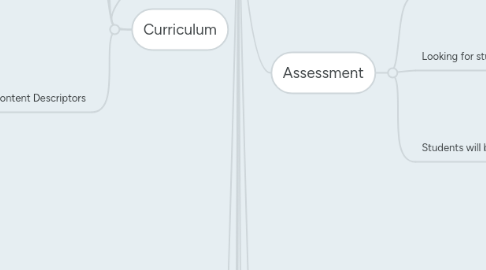
1. Time
1.1. 45 Minutes
2. Year Level
2.1. 2
3. Curriculum
3.1. Learning Area
3.1.1. Technologies - Design and Technologies
3.2. Learning Area Strands
3.2.1. Design and Technologies Knowledge and Understandings
3.2.2. Design and Technologies Processes and Skills
3.3. Content Descriptors
3.3.1. Knowledge and Understandings
3.3.1.1. Explore how technologies use forces to create movement in products (ACTDEK002)
3.3.2. Processes and Skills
3.3.2.1. Explore needs or opportunities for designing, and the technologies needed to realise designed solutions (ACTDEP005)
3.3.2.2. Visualise, generate, develop and communicate design ideas through describing, drawing and modelling (ACTDEP006)
4. Students Prior Knowledge
4.1. Students have had one previous lesson
4.2. What catapults are
4.3. Their purpose
4.4. How they work
5. Learning and Teaching Adjustments
5.1. YouTube video, images and playing with catapults to cater to visual, hands on learners.
5.2. Assist those students who need extra assistance
5.3. Group work so students can work together
5.4. Class discussion and small amounts of written work to cater to those who are not strong in written work
6. After Learning Experience Reflection
6.1. Evaluation of students' learning
6.1.1. Assess in terms of the specific learning goals
6.1.2. How well students have completed the activities
6.1.3. The extent to which they show understandings
6.1.4. Note any misunderstandings
6.2. Future action for students
6.2.1. Plan the building of their catapult and what they will be testing
6.2.2. Reteach any points needed
6.3. Self-evaluation
6.3.1. Evaluate how well the following items were done during the lesson;
6.3.1.1. Behaviour management
6.3.1.2. Planning and Preparation
6.3.1.3. Learning experience structure
6.3.1.4. Activities and teaching strategieis
6.3.1.5. Resources
6.3.1.6. Time management
6.3.1.7. Presenting of lesson
6.4. Future action for self
6.4.1. Improve on any of the points as stated in self-evaluation
7. Links to other learning areas
7.1. English
7.1.1. Group and class discussions and interactions (ACELY1666) (ACELY1789)
7.1.2. Reading and comprehension of the procedure (ACELY1670) (ACELY1669)
7.2. Mathematics
7.2.1. Count the amounts needed for each material (ACMNA027)
7.3. Science
7.3.1. Make predictions and respond to and pose questions (ACSIS214) (ACSIS037)
8. Learning and Teaching Strategies - Body
8.1. Discussion - Introduce task
8.1.1. 5 min
8.1.2. Students will build a catapult
8.1.3. They will investigate how they can change how far the object being launched moves
8.2. Brainstorm - materials
8.2.1. 5 min
8.2.2. Focus questions
8.2.2.1. How could the catapults be made?
8.2.2.2. What materials will you need?
8.2.3. As a class on whiteboard
8.2.4. What materials might be needed to build a catapult
8.2.5. Think time before brainstorm
8.3. Discussion - procedure
8.3.1. 10 min
8.3.2. Focus questions
8.3.2.1. What materials will you need?
8.3.2.2. What materials will we be using?
8.3.2.3. What materials were the same and different?
8.3.3. Display the procedure to build a catapult on interactive whiteboard
8.3.4. Compare materials brainstormed to required materials
8.3.5. Read and discuss the steps
8.4. Group brainstorm - how can students change how far the object launches?
8.4.1. 10 min
8.4.2. Focus questions
8.4.2.1. How could you change how far the object moves?
8.4.2.2. How can you make the object move a small distance?
8.4.2.3. How can you make the object move a larger distance?
8.4.3. Groups of three
8.4.4. Students brainstorm how they can change how far the object launched moves
8.4.5. ie. using more or less force
8.4.6. Class discussion of brainstorms
9. Learning and Teaching Strategies - Conclusion
9.1. High-five pair up
9.1.1. 5 min
9.1.2. Focus questions
9.1.2.1. How could you change how far the object moves?
9.1.2.2. How can you make the object move a small distance?
9.1.2.3. How can you make the object move a larger distance?
9.1.3. Students walk around the room and high-five another student to pair up
9.1.4. In pairs explain how they could make the object travel a longer or shorter distance
9.1.5. When finished they pair up with someone else
10. Learning Experience Focus
10.1. Introduce task
10.2. What the task requires
10.3. Materials needed
10.4. Processes
11. Unit Topic
11.1. Catapults
12. Specific Learning Goals
12.1. State how they can change how far the object being launched from the catapult moves.
12.2. State how they could make the object travel a longer distance when launched from their catapult.
12.3. State how they could make the object travel a shorter distance when launched from their catapult.
13. Assessment
13.1. Formative Assessment
13.2. Looking for students’ abilities to;
13.2.1. State how they can change how far the object being launched moves
13.2.2. State how they could make the object move a longer or shorter distance
13.3. Students will be assessed through;
13.3.1. Observation
13.3.2. Anecdotal notes
14. Teaching and Learning Strategies - Introduction
14.1. Discussion - Review previous lesson
14.1.1. 5 min
14.1.2. Focus questions
14.1.2.1. What did we do last lesson?
14.1.2.2. What is a catapult?
14.1.2.3. What is the purpose of a cataoult?
14.1.2.4. How do catapults work?
14.1.2.5. What materials were catapults made of?
14.1.2.6. How could the catapults be made?
14.1.2.7. How are catapults a form of technology?
14.1.3. What catapults are
14.1.4. How they work
14.1.5. What they are made of
14.1.6. How they are a form of technology
14.2. General capabilities
14.2.1. Literacy
14.2.2. Critical and creative thinking
14.2.3. Personal and social capability
14.2.4. Numeracy
